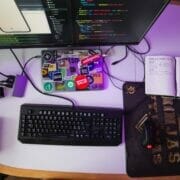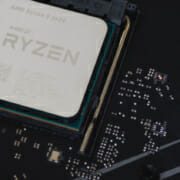Want To Develop iOS Apps? Here’s How To Get Started
Most developers — even those not involved in the mobile space — want to develop iOS apps. And that’s because Apple’s renowned ecosystem is world-class. And with the recently released iPhone Pro 14, consumers have access to one of the best premium smartphones in the market.
Of course, iOS apps don’t only run on iPhones but also on Apple’s phenomenal lineup of tablets — the iPad range. And with the introduction of Apple silicon (system on a chip based on ARM architecture), it’s now possible to run iOS apps on the latest Mac computers with no porting necessary.
So what does this mean for developers? It means that their iOS apps can run on a variety of Apple devices from a single codebase. And that’s profound because Apple users love to spend money on apps far more than Android users. Thus, if you develop iOS apps, you’ll be entering a very lucrative market. And while success is never guaranteed — you’ll never know if you don’t try!
But what if you’re new to the Apple ecosystem as a developer — how do you even get started? First and foremost, understand that Apple’s ecosystem is called a ‘walled garden’ for a reason. And that’s because it’s a closed platform, similar to Sony’s PlayStation and Nintendo’s Switch consoles.
And that brings us to our second point: you don’t have the freedom to develop iOS apps on whatever hardware you like or skirt Apple’s guidelines. Like it or not, Apple has a stranglehold on its platforms, down to the development process. But we plan to demystify this process and help you get started — the right way!
1. Purchase Original Apple Hardware
If you don’t already own an Apple MacBook notebook or a Mac/iMac desktop, you’ll need to purchase at least one that fits your budget. Preferably, choose one of the latest models that features the M1 or M2 SoC instead of an Intel CPU. Apple’s latest chips are more power efficient and also future-proof, so worth the investment.
Now, you may come across instructional articles and YouTube videos that will show you how to build a Hackintosh — a cheaper and unofficial Mac/iMac clone system. As tempting as this route may seem, we don’t recommend it at all! You’ll need some PC-building skills, and the overall experience won’t be as smooth as using a genuine Mac once you’ve got your Hackintosh up and running.
And no, you won’t be able to use a Windows or Linux PC to build iOS apps. But you can install Windows or Linux on a Mac and even develop apps for these operating systems. Moreover, you can install Android Studio on a Mac and develop Android apps, making it perfect for cross-platform development.
You’ll also need to purchase at least one iPhone and an iPad for deploying and testing your app. And if you plan to release your app on Apple Watch and tvOS, you’ll need to purchase these devices too. Purchase the latest models of these devices, but it doesn’t hurt to have a few older models in the studio for backward compatibility testing purposes.
2. Enroll As An Apple Developer And Create An Apple ID
Now that you’ve rounded up all your hardware, you’re ready to become an Apple developer. However, we mentioned Apple’s closed platform earlier, and now you’re about to see why that’s the case.
Apple offers an enrollment program, and it’s mandatory if you want to distribute your iOS apps. Furthermore, you’ll need to pay an annual fee of 99 USD for the Apple Developer Program and 299 USD for the Apple Developer Enterprise Program. Choose the program that’s right for your studio.
Also, don’t forget to create your Apple ID, as it’s necessary to authenticate yourself as the user and to download development tools from the Mac App Store.
3. Download And Familiarize Yourself With Xcode
After that, download Xcode — Apple’s official integrated development environment (IDE). You can get it from the Mac App Store or Apple’s Xcode developer portal. This suite includes a code editor, debugging tools, and the iOS software development kit (SDK). While there are many other IDEs available in the marketplace, we recommend you stick to Xcode if you’re only now starting out to develop iOS apps.
However, if you’re developing mobile games and using a game engine such as Unity, expect your development environment to differ substantially. But if you’re developing non-gaming and line of business (LOB) apps, Xcode will suffice.
We recommend you spend time familiarizing yourself with Xcode before you start to develop iOS apps. And that’s to help you and your team to become more comfortable with using the IDE and all its features. Furthermore, check out the Xcode documentation, videos, and forums at Apple’s developer portal.
4. Learn The Swift Programming Language
Swift is Apple’s officially supported and preferred programming language for creating iOS apps. It’s quickly replacing the far older Objective-C, but some developers still use it to this day. However, we recommend you use Swift as a new iOS developer, as it’s easier to read and write and more type-safe.
But how long will it take to learn Swift? If your team already has experience with any object-oriented programming (OOP) language, they’ll pick up Swift in a matter of days. But if they have little or no experience, it can take two months or longer to gain a basic level of proficiency.
5. You May Need To Learn C++ Or C#
If you’re planning on developing an iOS mobile game, you can use Xcode. But we only recommend this route if you’re making a small and simple game. And that’s because Xcode doesn’t offer the tooling necessary to make complex 3D games popular with today’s gamers.
Instead, you should either use Unity or Unreal Engine to make a compelling game with stunning 3D visuals. If you go with Unity, which is the more lightweight game engine of the two, you’ll need to learn C#. And if you go with Unreal Engine, you’ll need to learn C++ or Blueprint Visual Scripting.
Overall, C# is easier to learn than C++, and even shares some similarities with Swift. And that means if you already know Swift, picking up C# will be a cinch. However, that doesn’t mean you should ignore C++, as it’s the lingua franca of the game development world. And apart from Unreal Engine, the vast majority of performance-oriented 3D game engines are either coded in C++ or have a C++ scripting component.
Furthermore, if you need to develop a fast-paced game, such as a first-person shooter (FPS) or racing game, it’s preferable to code it in C++ to keep frame rates up. The problem with languages such as C# is that they use a garbage collector (GC) to avoid memory leaks. But every time the GC kicks in to clear unused objects in the memory heap, it can cause in-game stutters, which ruins the user experience.
Of course, there are workarounds to avoid these stutters, but it’s still better to use a more performant language, such as C++. And given that C++ regularly outperforms managed languages such as C#, it’s the way to go for many use cases.
In Conclusion
As we’ve revealed, it’s actually a relatively simple process to develop iOS apps if you’re just starting out. Initially, you’ll be faced with a high price of entry, especially if you don’t already own any Apple hardware. But once you have purchased this hardware, created your Apple ID, and enrolled in the developer program, you’re halfway done. Then, it’s a matter of downloading Xcode, familiarizing yourself with the IDE, and learning Swift.
You may need to use other tools and programming languages if you’re creating mobile games, but this isn’t always necessary. Contact us today to learn how NS804 will help you develop iOS apps that engage users!











 https://unsplash.com/photos/9e9PD9blAto
https://unsplash.com/photos/9e9PD9blAto
Leave a Reply
Want to join the discussion?Feel free to contribute!